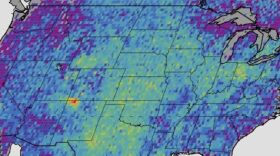Sometimes what looks like a white plastic bag snagged in the top of a pine tree is only a plastic bag. Sometimes it’s something else – a bag of bugs, you might say.
Those silky-white tents hanging high up in ponderosa pine and juniper trees are the homes of web-building caterpillars that are the larvae of tiger moths. A hundred or so caterpillars share each tent. Each day they feed on the tree’s needles. Together they can kill or deform the topmost branches, but they generally don’t permanently injure the trees.
Adult tiger moths lay eggs in mid-summer. The caterpillars hatch in September or October, pitch their collective tents, and begin munching the needles. Sometimes they can be seen marching up and down the tree’s trunk.
An inch long, the caterpillars are decorated in black and yellow. Small hairs protruding from their bodies are irritating to birds and other potential predators – and to some people, so it’s best not to touch them.
The caterpillars overwinter inside their web and start feeding again when the weather warms in spring. In May or June they spin cocoons; then the adult moths emerge and take flight. Some are striped in gold and black, others in red, white, and gray.
The showy colors are a tipoff to predators that the moths don’t taste good. Safe from most predators, the adult moths are soon ready to produce another generation – giving onlookers more reason to do a double-take when they see those white bags snagged in the treetops.







